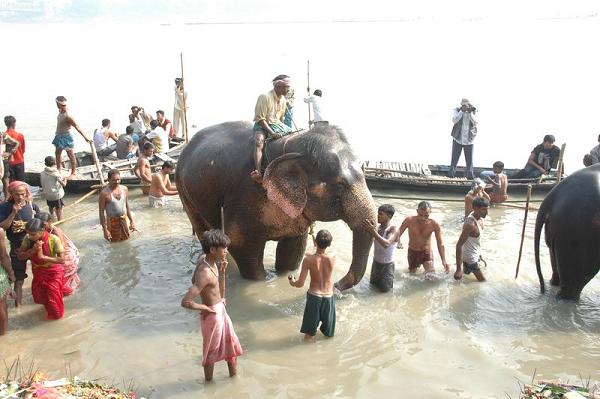|
(Bihar Times) Few know that Sonepur which is downstream of Patna on the northern bank of the Ganga was once the largest cattle fair in the world. And to unload all the animals that were brought in from other parts of India Sonepur railway station was the longest in the world.

The fair was formally inaugurated by the Viceroy of India who travelled down to Sonepur for the occasion. And that was on the full moon day of the Hindi month of Kartik. This was also the formal declaration of the opening of the winter. That meant men of the army, police and others could start wearing their shirt-sleeves down and jerseys over them.
This would also bring down British troops and others stationed at hill-stations for their winters. Their families would also come down from the hills.while the government and High Courts would move their offices to their winter capitals -- from Ranchi to Patna for instance.
On Kartik Purnima the whole of the Sikh world also celebrates the birth anniversary of their first guru, Guru Nanak, whose memorial, Har Mandir Sahib stands in the older part of Patna. And on this day Vishnu married Tulsi.
This story tells us about how Lord Vishnu once happened upon a stunningly beautiful woman named Brinda as she moved around in front of her house. Her husband was away and Vishnu knew he would be back for sometime. In one moment of utterly shameful weakness he turned himself into her husband and returned to live with her.
When the husband did return, Brinda was enraged. She cursed Vishnu soundly. He admitted his guilt and agreeed to marry her. And among the various blessings he bestowed on her was that she would flourish anywhere, even in unclean places, even at the back of houses and that no Hindu puja would ever be complete without her.
However, we were talking about Sonepur Fair.
Sonepur or Swarnpur as it must once been known marked the southern-most tip of the kingdom of Kind Prajapati Daksha, father of Sati who was married to Lord Shiva. That is one claim to fame of Sonepur.
The other was that in the Ganga roundabout here lived a gharial -- by the way this Gangetic entity is so known because it has a small strange growth on the tip of its nose which is shaped very much like a ghara or pot in which we fill water -- and the gharial was a devout devotee of Lord Shiva.
Also on the banks near here lived an elephant which worshipped Lord Vishnu.
Once when the gaj was having a drink of water from the Ganga the gharial caught at its hind leg and hung on. No way would the gharial let the gaj go struggle though he did and no way could the elephant loosen the vicious teeth sunk into his leg.
Just then he saw a lotus floating down. He reached out and snatched it from the water and raised it the sky, calling upon Lord Vishnu to help.
Meanwhile the gharial was praying to his lord to come to his rescue.
Both responded, both appeared. And that is why Sonepur was originally known as the Hariharkshetra Mela. Hari is Vishnu, Har is Mahadeo (Hardwar is actually Hardwar and NOT Haridwar as usually pronounced today)
The British would celebrate the departure of the intense, scorching heat from the renowned Indo-Gangetic plains by making it a vast festival centered around animals. There were horse shows, races, tent-pegging, etc. And prizes for cows that gave the most milk, for here you could buy Bahmanis and Jerseys.
That last time I was at Sonepur Fair I found some men walking a stary-eyed cow, visibly in agony round and round a rough pen. When I asked what the matter was they told me she had lost her calf in transit and could not lactate without him. They were trying to tire her out so that her udders would relax enough for her to let them milk her.
Looking at her massive swollen udders I asked how much milk she gave and they said, 'Forty-five kilos.' And her price? 'Rs 45,000.'
And this was 15 years ago.
This was where rajas maharajas and proprietors of circuses came looking for elephants to buy and this is where people came to buy birds of all shades and descriptions, smaller mammals like deers and arab horses.
Something else that that Sonepur Fair is famous for is its 'nautch girls'. British troops, far from homes and families, starved for female company, having wintered in the upper reaches of the inhospitable Himalayas found themselves riding on loosened reins here. And the best nautch girls from China, Bengal, Nepal and other south-east countries were to be found here.
The scenes one saw in Amir Khan's film, Mangal Pandey of such girls being given a thorough medical examination was also gone through here. And the festival went on for the full month of Kartik.
The real origins of Sonepur Fair are not really known. Yes, of course, it must have something to do with our great Pashupatinath. Also the fact that the mighty Ganga waterway that made Pataliputra the commerce capital of the ancient world for more than a couple of centuries must have had something to do with it. Otherwise how does one explain the presence of cheetahs in an Arab Sheikh's tent or Bahmani cows in Britain and United States?
|